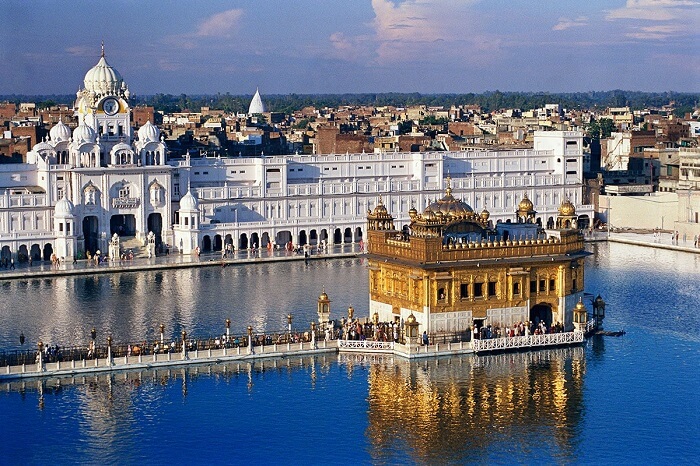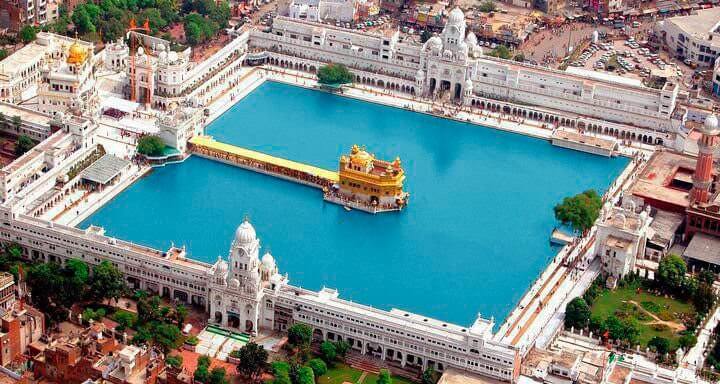Golden TempleThe Golden Temple is known as Shri Harmandir Sahib or Darbar Sahib. The word Harmandir is made up of two words: Hari + Mandir. It means 'The Place (Temple) of God'. This temple is the most holiest and significant place for all the followers of Sikhism. And not only Sikhs, but people from every religion also come to bow down at this pilgrim site. This Gurudwara gives the message of unity, brotherhood, and equality to the whole world. Today, let's know together about the history, architectural design, significance and facts about the Golden Temple: Location of the Golden TempleThis Gurudwara is located in the city Amritsar, Punjab, a state of India. The temple is the marvelous center of attraction of the entire city of Amritsar. Every day, thousands of tourists and devotees come to see this symbol of peace, brotherhood, and harmony. The pool built around this temple was built by Guru Ramdas, the fourteenth guru of the Sikhs. After this pool, this city was also named Amritsar. This Gurudwara is situated exactly in the middle of this lake. You are thinking that it is a Gurudwara, after that its name is Golden Temple. This additional word temple shows that all religions have equal recognition in India. It defines the unshakable unity of the nation. 
The amazing history of the Golden TempleThe temple was established in 1574 by Guru Ram Das, the fourteenth Guru of the Sikhs. Another truth about this Gurudwara is that this Gurudwara has been built to strengthen the unity between all people and religions. Later, in 1604, Arjun Singh, who was the fifth Sikh Guru built the first Harmandir Sahib. But it is said that a Muslim Sufi Mian from Lahore (now in Pakistan), lay the foundation stone of the Darbar Sahib. Guru Arjun Singh has also built the four entrance gates, which indicates that people from all religions can come to this holiest place. Many outsiders, specially Afghani invaders tried to destroy this great symbol of Indian unity. But the brave rulers of Punjab always protected and renovated this temple. During 1801-1839, the great king, Maharaja Ranjit Singh reconstructed with marble and copper. He coated the temple with gold foil. As a result, the edifice was dubbed the Golden Temple. On 6 June 1984, after independence, when the Indian Army was fighting with the soldiers of the enemy country to save the country. Even then the Harmandir Sahib had suffered heavy damage. And at that time the Akal Takht was also attacked. But within few months both the structures were later repaired. There is a committee that is responsible for the management of the Golden Temple. The committee name is Shiromani Gurudwara Parbandhak Committee (Supreme Committee of Temple Management). The main office of the committee is located in the northern direction of the pool. They control and manage this important Sikh Gurudwara. The architecture of Golden TempleThe architectural design of this temple also shows that all religions are considered equal in India. People of all religions and their ages have contributed to making this Gurudwara. The design done on the lower part of this gurudwara is a unique example of Hindu and Islam architectural art. Real gold has been used to make the upper part of this temple. There is about 750 kg of gold in this temple. That's why it has called Golden Temple. When the sunlight falls on this golden temple, its radiance gets brighter. Amrit Saras: The Pool of NectarThe Harmandir Sahib is the focal point of a series of structures that form Sikhism's heart. The temple is located on a small island in the middle of a pool, known as the Amrita Saras ("Pool of Nectar"). The city was named Amritsar after this pool. Temple employees deliver water from the temple's surrounding pool. The water is revered, and travelers take bottles home with them for purification and health. When the reflection of the Golden Temple is seen in this lake, then it looks more beautiful. The whole city of Amritsar is situated around this pool. 
Largest Community Kitchen in the WorldThis Gurudwara is also known around the world for its largest community kitchen. The assembly hall and the Guru Ram Das Langur, is a dining hall that provides free meals to thousands of visitors every day. All the visitors and devotees eat meals by sitting on the floor. The gurudwara serves food to everyone either rich or poor, or Sikhs or from other religions, male or female, etc Harmandir Sahib, one of the largest Sikh Gurdwaras, offers a free kitchen that serves 100,000 people per day. To accommodate any dietary concerns, gurudwaras serve vegetarian food. Back in the 15th or 16th century, Guru Nanak Dev Ji gave the message on equality. They believed in humanity, not in religion, caste, or gender. That's why for the temple's guests, Sikhs prepare chapatis, a flatbread. The devout traverse a causeway, or boardwalk, across the surrounding pool to reach the temple's golden heart. Sikhs can bathe in the water, which is considered purifying, from the outside platform. Along the walkways, you'll notice temple employees carrying buckets of water to the worshippers. Devotees bathe in the holy lake of the Golden Temple. All guests must enter barefoot and must wash their feet in a separate pool before entering. Significance of the Golden TempleThis Gurudwara has a total of 4 entrances in all four directions. These entrances symbolize that the people of any religion and caste are allowed to enter this Gurudwara. With as much love as this Gurudwara invites people of all religions, with the same love and devotion, people of all religions come here to bow their heads in front of the Supremacy. Sikhism and this Gurudwara is the symbol of peace, humility, brotherhood, and equality. Also, the characteristic hat, unshorn hair, a wooden comb, an iron bracelet, and a ceremonial blade are worn by initiates as emblems of these principles. In the 15th and 16th centuries, the founding gurus of Sikhism declared that women were equal to men in God's eyes. Without any kind of discrimination, caste, religion, gender, and social status, all the people are equal in this kitchen. They satisfy the hunger of every hungry in this Gurudwara. In this kitchen, they not only serve food, but also they serve humanity. Interesting facts about Golden TempleLet's know some interesting facts about the Golden Temple given below:
Next TopicISKCON Temple
|
 For Videos Join Our Youtube Channel: Join Now
For Videos Join Our Youtube Channel: Join Now
Feedback
- Send your Feedback to [email protected]
Help Others, Please Share









